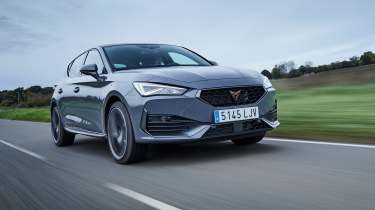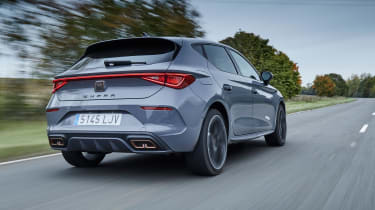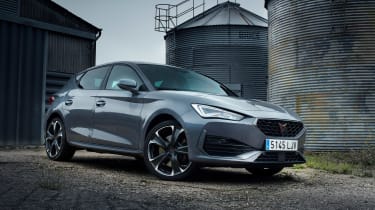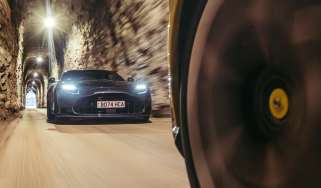Cupra Leon eHybrid 2020 review – are hybrids and hot hatchbacks still mutually exclusive?
Cupra’s hybrid hot hatch isn’t really sure what it wants to be – wait for the regular Cupra instead
Punitive taxation will see plenty more manufacturers turning to hybrid hot hatchbacks over the coming years, and SEAT’s performance brand Cupra is getting in on the act early with the new Cupra Leon eHybrid. Matching the conventional Cupra Leon on output but promising high economy and low CO2, is it worth considering?
Engine, transmission and 0-60 time
Like the old Golf GTE (and indeed the new one) the Cupra eHybrid uses a 1.4-litre TSI petrol engine paired with an electric motor. The former makes 148bhp and 184lb ft of torque, the latter 113bhp and 243lb ft, but as is typically the case their combined efforts result in figures different from simply adding both pairs together: 242bhp and 295lb ft.
The other relevant numbers are six (the number of ratios in the dual-clutch transmission), 12.8 (the capacity, in kilowatt hours, of the lithium-ion battery) and 32 (approximate grams per kilometer of CO2, with UK figures yet to be confirmed). Here are two more: 6.7sec to 62mph, and 140mph flat out.
Technical highlights
Actually, there’s one other number worth mentioning: the 1596kg kerb weight. It was this that always made Volkswagen’s old Golf GTE feel a bit slovenly compared to its GTI counterpart, and it’s also a good excuse for charging the eHybrid every time you get a chance. You can still drive around on petrol power when the battery depletes, but do so and you’re lugging around all that weight for nothing. Cupra quotes 32 miles of all-electric range – a real-world 20-25 miles is more likely.
What’s it like to drive?
The Leon eHybrid is a car with an identity crisis, stuck between the apparently disparate aims of hot-hatch style thrills and easy-going hybrid cruising. Concessions to the former hinder the latter and vice versa, and the resulting experience is predominantly disappointing, save for a few flashes of talent here and there.
More reviews
Group tests
- Lotus Emira Turbo SE v Alpine A110 GTS – two of the last surviving mid-engined sports cars
- Alpine A290 v Alpine A110 – how much DNA do they really share?
- Ariel Atom 4R v Caterham Seven ‘evo25’: power-to-weight heroes go head-to-head
- Ariel Atom 4 v Caterham Seven 310R v Lotus Elise Cup 250
- £200,000 supercar shoot-out: AMG v Aston Martin v Maserati v McLaren
- Audi Quattro, RS2 and RS3: five-cylinder icons head-to-head
- Who makes the best GT car? Aston Martin v Bentley v Maserati
- Caterham Super Seven 600 v Super Seven 2000
- Corvette Stingray v Porsche Cayman GTS v Audi R8 RWD
- GMA T.50 v McLaren F1 – has the best car in the world been dethroned by its successor?
In-depth reviews
- Abarth 600e 2025 review – Italy gives the Alpine A290 something to worry about
- Alpine A110 review – the sports car Lotus should be building
- Aston Martin Vantage 2025 review – a thrilling Mercedes-AMG GT and 911 Turbo S alternative
- Used Audi RS2 (1994) review – an unsung '90s hero you can own for £40k
- Audi R8 (2015 - 2024) review – the ultimate soft-focus supercar
Long term tests
- Abarth 695C Turismo Fast Fleet test – living with the charming Italian hatch
- Alfa Romeo Giulia Veloce long term test – can Italy beat Germany?
- Aston Martin Vantage (2006) Fast Fleet test – living with a £30k V8 Aston
- Caterham Seven evo25 Fast Fleet test – living with a track car for the road
- Caterham Seven evo Edition revealed – bespoke 420R joins the Fast Fleet
- Cupra Leon 300 Fast Fleet test – living with Spain's 300bhp hot hatch
- Cupra Ateca VZN Fast Fleet test – four months with Cupra's hot crossover
- Cupra Leon Estate 310 4Drive Fast Fleet test – living with the 306bhp hot estate
- Ford Mustang GT
- Ford Mustang GT
Review
- New Bentley Batur 2023 review – can it possibly be worth £1.65m?
- 2023 Chevrolet Corvette C8 Z06 review – the American 911 GT3?
- BBR Supercharged Mazda MX-5 (ND) 2023 review – tuned 250bhp roadster driven
- MG4 Trophy 2023 review
Reviews
- Abarth 695 75 Anniversario edition 2024 review – a fitting send-off for Abarth’s hot supermini?
- Abarth 500e 2023 review
- AC Cobra 378 Superblower MkIV 2021 review – another V8 Cobra, but with a GM heart this time
- Acura Integra Type S 2024 review – a Honda Civic Type R with added restraint
- Alfa Romeo Giulia review – get one while you still can
- Alfa Romeo 33 Stradale 2025 review – a rare Italian jewel beyond compare
- Alfa Romeo SZ: history, review and specs of an icon
Starting with the good, the Leon has a fundamentally well-sorted chassis, with a balance of qualities that make brisk A- or B-road driving a fluid and intuitive experience. The steering is probably the highlight – it’s not much of a chatterbox, but it’s accurate without being darty and the weighting strikes a fine compromise between reassuring heft and modest effort.
It’s backed up with good front-end bite and a rear axle that’s willing to help point the nose where you want it. On 235-section Goodyear Eagle F1 Super Sport tyres there’s good grip too, but enough movement to feel when you’re testing the chassis – it’s capable, but not too tied-down, in other words. You can feel the weight compared to a conventional hot hatch, and the big 19-inch wheels are occasionally caught out by certain bumps, but in isolation neither is a great barrier to enjoyment.
Which is more than can be said for the powertrain. The pseudo five-cylinder growl in Sport and Cupra modes isn’t too bad and ramps up the drama, and outright pace is brisk enough, but the electric and petrol elements always seem to be fighting each other. The electric motor doesn’t quite have the power on its own for that satisfying EV-only thrust of a full-electric car, but rousing the engine takes several beats longer than you’d hope too. In the time it takes to wake and find the right gear, most conventional hot hatches would already have stolen several lengths.
You can shift manually of course (with the cheap-feeling, poorly positioned paddles) but there are still inconsistencies. On the overrun the engine is virtually silent and engine braking minimal even in Cupra mode, so you’ve little idea what gear you’ve changed down to until you accelerate out of a corner. The instrument cluster also regularly nags you in Sport and Cupra modes to change the gearbox back to its more economical Normal mode, and unless you’re braking hard, the brake pedal feels spongy, like it does in many hybrids.
Price and rivals
UK pricing is yet to be revealed, though if the old Golf GTI, GTD and GTE were anything to go by, you can expect to pay a grand or two more for the eHybrid than the conventional 242bhp 2-litre counterpart that’s also on the way. VW’s GTE will be the most obvious rival, though ignore the hybrid element and the £30k bracket is awash with hot hatches from virtually every manufacturer. Until something better comes along, our pick remains the Civic Type R.







